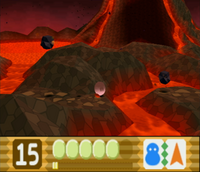Neo Star (theme)
| ||||||||||||||
|
| ||||||||||||||
"Neo Star"[derived from Japanese] is a theme from Kirby 64: The Crystal Shards. It was composed by Jun Ishikawa.[1]
Composition
"Neo Star" is a slow/moderate theme set at approximately 82.5 bpm in common time, predominantly in G Mixolydian ♭6 but with frequent departures in using minor thirds. These departures are used to render a chromatic submediant, with the predominant harmonic progression being I-I-♭VI-I (i.e., occasionally switching to the submediant from the tonic). The tonic/flat-submediant progression evokes a sense of a heroic journey through a fantastical and eerie setting, appropriate for the dark, cavernous settings of Neo Star.[2]
The theme is constantly underscored by prominent percussion, an aggressive synth bass line, and a complex, imposing array of various accompanying synth lines. A solo synth voice renders the primary melody for the first half, before a synth choir renders a response in the second half under the same tonalities. The choral voicing when combined with the tonic/flat-submediant progression evoke a sense of awe appropriate for the stages that this track underscores.
Game appearances
Kirby 64: The Crystal Shards
The original arrangement features in Neo Star - Stage 2 and Neo Star - Stage 4. It is available both in the game's Sound Check as track 007, and in the Hoshi no Kirby 64 Original Soundtrack CD as track 23.
Kirby: Canvas Curse
A rearrangement called "Volatile Volcano", also created by Jun Ishikawa, features in the stage of the same name, an active volcano not dissimilar in atmosphere to Stage 4 of Neo Star. Although faithful in tonality and melody, the rearrangement's instrumentation replaces the synth voices with entirely electronic sounds. In the game's Sound Test, this is track number 19.
Kirby Star Allies
The original version from Kirby 64: The Crystal Shards features in Sector B. In the Jukebox, the track is available as number 086.
Names in other languages
| Language | Name | Meaning |
|---|---|---|
| Japanese | コレカラスター korekara sutā |
Hereafter Star |
References
- ↑ Hoshi no Kirby 64 Original Soundtrack; Kirby Star Allies Jukebox
- ↑ Major-mode PL and LP transformations (in the Neo-Riemannian language of triads) are well studied in music theory contexts ranging from 19th century Romantic music all the way to contemporary pop and rock. See, for example:
- Murphy, Scott, Transformational Theory and the Analysis of Film Music, in David Neumeyer (ed.), The Oxford Handbook of Film Music Studies, Oxford Handbooks (2013; online edn, Oxford Academic, 16 Dec 2013).
- Forrest, David. PL Voice Leading and the Uncanny in Pop Music. Music Theory Online, 23, 4 (2017).
- Heine, Erik. Chromatic Mediants and Narrative Context in Film. Music Analysis, 37, 1, pp. 103-132 (2018).
| ||||||||||||||||||||
| |||||||||||||||||
